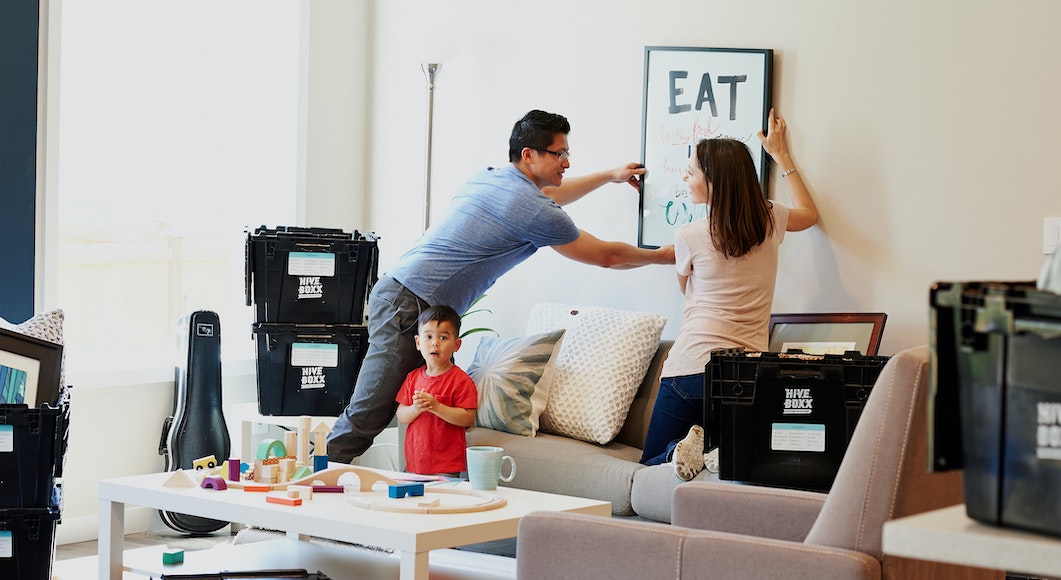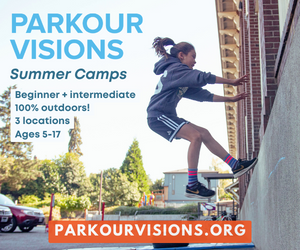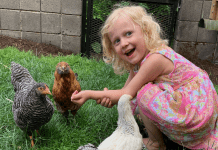I was unprepared for the barrage of tasks and to dos that came with buying a house. I mean, I knew it wasn’t a small task. And with the market the way it is, I expected everything would feel a bit more chaotic and stressful. But, wow! I have never quite experienced the thought-spinning that came with this process before — not even with the overwhelm of a new baby.
 And amid all of the lists and emotion cascades from excited to panicked, you remind yourself that it’s not just you that you have to think about. The smallest of transitions can be overwhelming for a toddler. Moving is like a sea of big and small changes taking hold simultaneously.
And amid all of the lists and emotion cascades from excited to panicked, you remind yourself that it’s not just you that you have to think about. The smallest of transitions can be overwhelming for a toddler. Moving is like a sea of big and small changes taking hold simultaneously.
There is no way through it but through it. The boxes have to move from one spot to another. You’re saying goodbye to the place you called home — and for your littles, perhaps the only place they ever called home. Everything will be the same but different; that is a lot to try and integrate, regardless of age.
Radical acceptance is a term that means to accept what is out of your control and anchor on the things you can. With moving, that’s even more important. We can’t control the timelines of others. We can’t control the outcome of the inspection. We can’t control shipping deadlines or inflation. We can’t control the traffic you hit when heading out with the moving truck. And we can’t control the emotions our little ones or the ones we feel in the process.
Spending time and energy worrying about or trying to manage these things does nothing but deplete our already limited supply of resources. Instead, here are 10 things you can control that can make all the difference in helping your family during a move.
Be open about what is going on and involve them in the process.
Talk to them about why you are moving. Share with them the different steps. Begin talking about the move as soon as you are considering it. We looked at home-buying apps with our daughter, Everly, and took her to every showing. She came with us the first time we met our realtor and we talked a lot about why we were looking to buy a home. We never talked about our current home as if it were bad or with negativity. We just noted the things that didn’t work for us anymore and talked about how cool it would be to find the right place to move together.
Help them see themselves in the space.
This includes helping them visualize what games you will play in the backyard or where their toys will go. When they move, they may also need assurance that all of their things will come with them (see the tip on purging below).
Can they pick the color they want to paint their new room? Which bathroom will be theirs? It can be especially helpful to help them start visualizing what a routine will look like there. Where will they eat? Take a bath? Where will you do story time?
Everly is obsessed with painting, so we took her to Home Depot and let her pick out a bunch of paint swatches to put up in her room while she decided which color blue her walls would be. We knew how much she loved bath time so we went and sat in the bathtub and did a pretend bath when we first looked at the house. And when we returned after our offer was accepted, we took my mother-in-law and let Everly give her a tour of her new home so she could start to claim the space and get excited.
Talk about their feelings — every day.
This is going to be a lot for all of you. It is stressful and a lot of excitement and grief are happening in tandem. Make space to check in every day how each of you is feeling. Allow the feelings to exist and try not to “fix” or put a positive spin on them. Let them have a day to be mad or sad. Normalize the experience. If they are having difficulty talking about how they feel, you can also use their toys to help. Ask their teddy bear how they are feeling moving to the new home. Ask them what they will miss and also what they are excited about or want to do when they first get there.
It’s nice when our kids are happy and go with the flow, especially when things are already stressful. But they don’t owe us that. They get to feel how they feel and making space for it is one of the best ways to help ensure it doesn’t build up and lead to tantrums or larger behavioral displays.
Consider the “safety” factor.
They are leaving their home base. This may not have been your forever home but this was a significant part of their life and is familiar and safe. The new home will take time to feel that way. We talked to Everly about how the first few weeks it might feel like we are on a trip or like this isn’t where we live now. She may feel sad or like she doesn’t have that same comfort right away. That isn’t because she isn’t safe in the new home. It is because her brain is familiarizing itself with our new home and our fear brains are very thorough inspectors for safety, security and comfort.
It can be helpful to set up certain spots in the home for them to call their own right away. That may be their rooms or even bringing in some of their comfort and familiar items to play with while you are unpacking and settling in.
Give them breaks from the process.
They don’t need to be involved in everything. Sometimes, they need a break from the process — and it can be a little easier on us to have some time without them for getting boxes lo aded and unloaded or doing harder tasks. If you can hire a babysitter or have a friend or loved one hang with them for a bit, do it. Try to maximize the time you spend getting some of the bigger tasks done and then bring them back into the fold later. Show them what you did and talk to them about what’s next. I even had one of her animals “help” me for the day and then talked to her about what they got to do with mom and dad all day to help get things ready for Everly to be in her new home.
aded and unloaded or doing harder tasks. If you can hire a babysitter or have a friend or loved one hang with them for a bit, do it. Try to maximize the time you spend getting some of the bigger tasks done and then bring them back into the fold later. Show them what you did and talk to them about what’s next. I even had one of her animals “help” me for the day and then talked to her about what they got to do with mom and dad all day to help get things ready for Everly to be in her new home.
When they are with you, be sure to take lots of space for breaks, play and cuddles.
We can become very task-oriented, especially when we are overwhelmed. But kids need breaks. When you get a few boxes unloaded, make a box fort or house. Can you ride a “roller coaster” of boxes in the basement? Can you make a table and chairs for a floor picnic?
It can be especially helpful to have a bin loaded up with favorite games, snacks, and toys to pull out during break time. We also made a moving playlist and would take dance parties randomly while packing. Everly also responded well to using timers, such as setting a 30-minute packing timer and then taking a 10-minute break.
Be consistent in routines and values.
A lot is in flux during a significant transition like this. And, it is essential to try and maintain as much of your routine as possible. From morning and evening routines, meal times and snacks, nap time rituals and bath time. Make sure you stay as consistent as possible with the times of day and the food and activities involved. We all know that ordering food or going out to eat happens a bit more during this time, which is completely normal. And, when possible, make sure you have things they are used to eating or are part of their regular diet. We packed a “transition” box that had some of her favorite snacks and lots of fresh fruit and veggies to grab when we were hungry. We also made plans for meals we could easily cook in the Instant Pot for our first dinner in the house or the breakfast she wanted after her first night sleeping there.
The other thing we focused on is consistency in values rather than behavior. We talk a lot about the value we have in our home of being kind to each other and keeping ourselves and others feeling safe and a part of the team. When one of us starts to get activated or stressed, it is easy to check if this behavior is in line with that value. Remember, all of you will feel scattered and overwhelmed. Everyone involved will have at least one tantrum and at least one pity party. Trust me, I get it. I had way more than that. When that happens, don’t get overly fixated on it. You are all doing the best you can. Come back to and talk about your family values and then consider what you could do next time to help you stay in line with them.
Be mindful of purging.
It’s easy to get into the purging mindset when you are moving. Suddenly you question if that toy they haven’t played with in 6 months really needs to make the journey to the new home. If you ask them, they will tell you they want it; they need it and you won’t be able to put anything in the donate bin. Try for a compromise. Instead, gather toys, books, and other items of theirs in a box. If there are some non-negotiable items, show them the items that will be getting the chance to play with other kids. With the rest, give them choices. Show them three toys and let them pick one to take with them.
Toddlers are vaults of information. They will remember the most random items — things they may not have seen to talked about for months. And suddenly, they are ready to read the book or play with the toy and if you gave it away without talking to them, it erodes the trust. While it can be easier to purge when their backs are turned, don’t. This way, they know up front. They can be sad or mad but don’t lose trust in you.
Account for all of the new transitions.
It’s not just the new home. It’s the new route to school or possibly a new school. It might be an new grocery store, library, parks, and friends. Try to be mindful of how taxing this can be for them and give them space to process each one as you go. Walk the neighborhood. Schedule extra time on your first trip to the new grocery store so you can get the lay of the land.
Most important is any school transition. This is a major part of their lives and it can take a lot of time for them to feel at ease going to school. Their brain may be working overtime to manage all the new inputs, so expect them to be more tired, irritable, clingy or sad. This is entirely normal. Again, talk about it. Take extra time to connect with their teachers. Try and set up a playdate with someone in their class early on. Like all transitions, we eventually fall into the routine — this is no different.
Give it time.
This is hard. Hopefully exciting, too, but hard nonetheless. Remind yourself that you AND YOUR KIDS are doing the best you can every day. None of you are failing. You are just going through something powerful together. Be in the process rather than getting fixated on the outcome or end point. Find joy in each moment and take space to just be with each other in this new adventure.


















